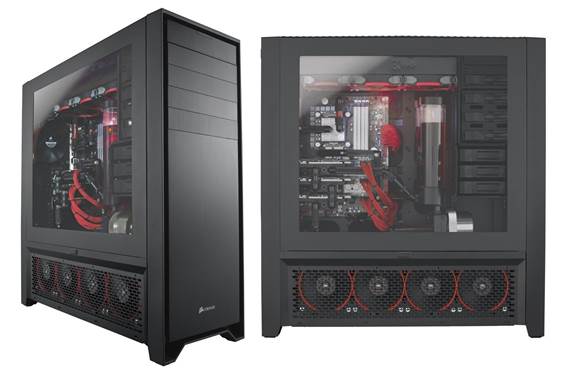Cue Also spmch Zamthustra for this
monolith
There’s much to like about Corsair's 900D,
given that this cast-aluminum-and-steel chassis weighs as much as a tank and
casts an authoritative presence underneath one's desk - if you can even fit the
full-tower case under there.
Our problem? The case's adornments aren't
as good as its overall construction. You could probably pull an Indiana Jones
and survive a nuke if you wedged yourself into the approximately 26x10x27-inch
case, but you're still going to have to fuss with its drive bays, magnetic
filters, panels, and other upgrade-critical parts.

Also
hidden behind a panel is the case’s ample connectivity: two USB 3.0 ports (with
an internal header) and four USB 2.0 ports
We love the aesthetic created by the case's
simple, flat facade. A giant cover on the bottom half of the case's front pops
off to offer easy, push-snap access to its three front 12cm fans (and
corresponding fan filter). Locking the filter back into place can feel a wee
bit flimsy, but we'd almost rather have that than the far more secure covers over
the case's four 5.25-inch drive bays. You have to shove your hand into the case
and do some blind-nudging of tabs to pop off the panels; we wish they were more
accessible from just the front alone.
Also hidden behind a panel is the case’s
ample connectivity: two USB 3.0 ports (with an internal header) and four USB
2.0 ports. The stealth is a bit of a moot point, however, given that you won't
be hiding much of anything when you’re using said ports, and it's slightly
annoying to have to flip open a panel just to access them pretty as it might
look.

We've
long credited Corsair with setting the standard in cable management with the
800D, and the 900D doesn't disappoint
We give Corsair all the credit in the world
for making its case even more screw-free than what we’d otherwise expect to
find when describing a case as "screw less.” Removing the case’s main side
panels on both sides is as easy as pressing a button on the case’s rear and
gently pulling the panel away. While we’re on the subject, we love the quasi polarized,
reflected look of the 900D’s left-side panel: By eschewing the typical clear
Plexiglas, Corsair adds to the mystique of the case's no-nonsense design.
The case’s 5.25-inch bays all use
easy-to-manipulate locking mechanisms to keep one's parts and pieces in place.
The hard drive trays that fill the case's nine free bays including three hot swap-friendly
bays with SATA power and data backplane are a bit fussier. The better word
might be "flimsier,” as they don’t feel all that sturdy when you pull them
out, push them in, or lock them into place. It's a minor quibble, but still a
technical flaw for a case that breaks the bank at $350.
The case’s 10 expansion slots require you
to spin thumbscrews to lock your components into place. Get ready for some
finger fun, because the case's design makes it difficult to use a
standard-length shank screwdriver on these little guys.

The
case’s 10 expansion slots require you to spin thumbscrews to lock your
components into place
We've long credited Corsair with setting
the standard in cable management with the 800D, and the 900D doesn't
disappoint. There's plenty of cable management built into the case’s
motherboard tray (standoffs, too), with eight large, rubberized holes and six
smaller holes for routing cables every which way. And we love how you can stuff
one or two power supplies into the case’s bottom portion, which is accessible
via its own flip-down side panel (with lame magnetic filter covering). Although
the 900D comes with five distinct locations for mounting liquid-cooling
radiators (yay), the case’s top is firmly screwed into the chassis itself you’re
going to have to do work to install a radiator anyway, we realize, but we’d
prefer to be able pop off the case's top sans instruments.
Finally, Corsair’s case lacks any and all
pizazz. You’re paying 100 percent for construction: no flashy lights, no strips
of LEDs, no ultra-quiet fans (just normal fans), no fan controller. And while
we absolutely enjoy some of the clever (and durable) construction work Corsair’s
put into its chassis, we can’t help but think that a few more tweaks could have
taken this case from "very good” to "absolutely great” especially
when the case itself eats up such a large chunk of your building budget,
|
Corsair 900D specs
Pros
·
Durable chassis
·
Absurd amount of space
·
Screw less
·
Separate partition for up to two PSUs
·
Three hot-swap bays
·
Ample connectivity
Cons
·
Flimsy drive trays
·
Odd angle for tightening expansion slot
thumbscrews
·
Screwed-in top
·
Lame magnetic filters for lower-partition
panels
·
Bay covers require interior access
·
Zero lighting
|